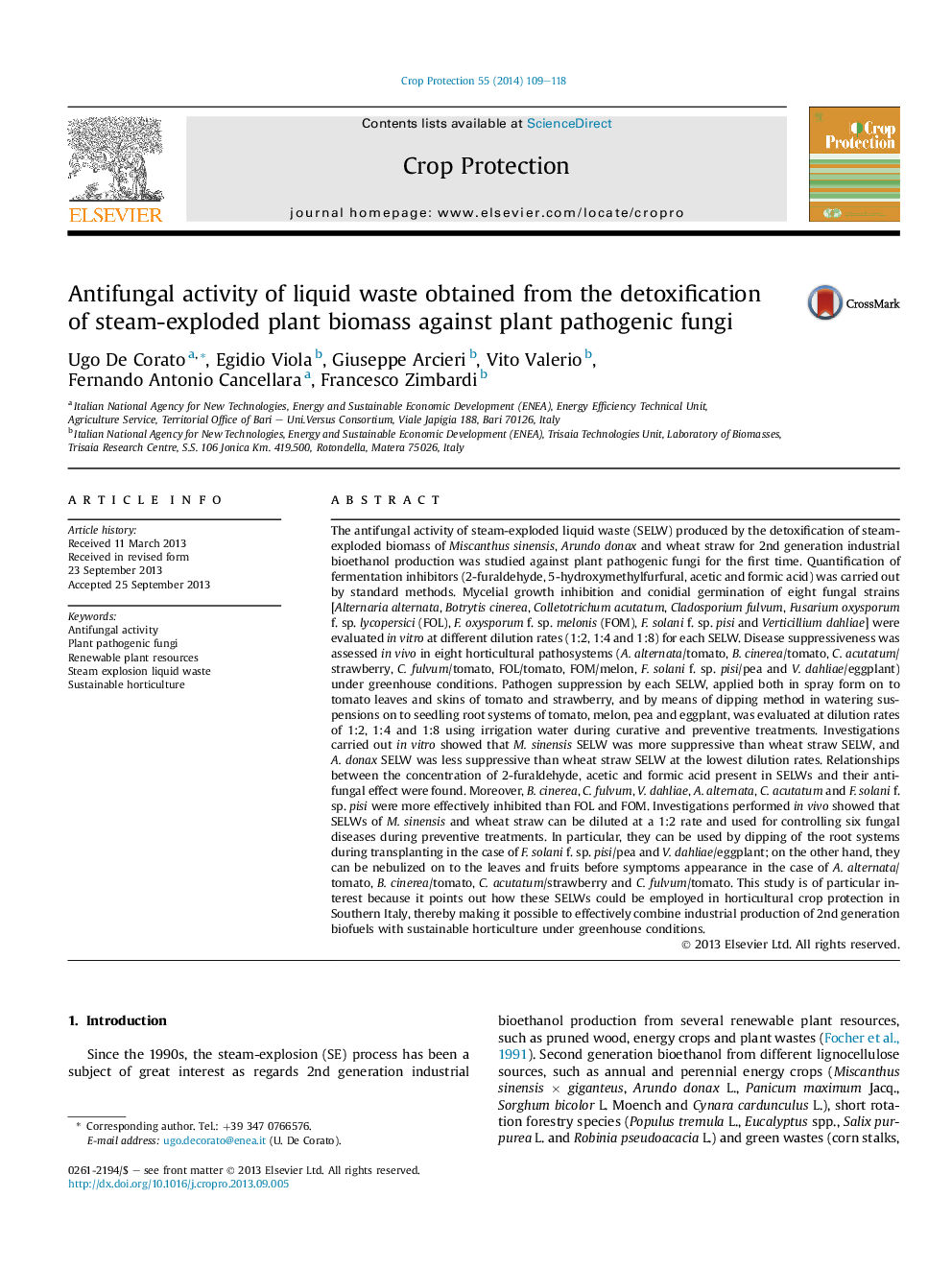| کد مقاله | کد نشریه | سال انتشار | مقاله انگلیسی | نسخه تمام متن |
|---|---|---|---|---|
| 4506003 | 1624332 | 2014 | 10 صفحه PDF | دانلود رایگان |
• The antifungal activity of steam-exploded liquid waste (SELW) has been studied in vivo.
• Quantification of 2-furaldehyde, 5-HMF, acetic and formic acid has been carried out.
• SELWs of Miscanthus sinensis and straw show suppressiveness against 6 plant pathogenic fungi.
• The research work points out how these two SELWs can be employed in crop protection.
• It is possible to combine production of biofuels with sustainable horticulture in greenhouse.
The antifungal activity of steam-exploded liquid waste (SELW) produced by the detoxification of steam-exploded biomass of Miscanthus sinensis, Arundo donax and wheat straw for 2nd generation industrial bioethanol production was studied against plant pathogenic fungi for the first time. Quantification of fermentation inhibitors (2-furaldehyde, 5-hydroxymethylfurfural, acetic and formic acid) was carried out by standard methods. Mycelial growth inhibition and conidial germination of eight fungal strains [Alternaria alternata, Botrytis cinerea, Colletotrichum acutatum, Cladosporium fulvum, Fusarium oxysporum f. sp. lycopersici (FOL), F. oxysporum f. sp. melonis (FOM), F. solani f. sp. pisi and Verticillium dahliae] were evaluated in vitro at different dilution rates (1:2, 1:4 and 1:8) for each SELW. Disease suppressiveness was assessed in vivo in eight horticultural pathosystems (A. alternata/tomato, B. cinerea/tomato, C. acutatum/strawberry, C. fulvum/tomato, FOL/tomato, FOM/melon, F. solani f. sp. pisi/pea and V. dahliae/eggplant) under greenhouse conditions. Pathogen suppression by each SELW, applied both in spray form on to tomato leaves and skins of tomato and strawberry, and by means of dipping method in watering suspensions on to seedling root systems of tomato, melon, pea and eggplant, was evaluated at dilution rates of 1:2, 1:4 and 1:8 using irrigation water during curative and preventive treatments. Investigations carried out in vitro showed that M. sinensis SELW was more suppressive than wheat straw SELW, and A. donax SELW was less suppressive than wheat straw SELW at the lowest dilution rates. Relationships between the concentration of 2-furaldehyde, acetic and formic acid present in SELWs and their antifungal effect were found. Moreover, B. cinerea, C. fulvum, V. dahliae, A. alternata, C. acutatum and F. solani f. sp. pisi were more effectively inhibited than FOL and FOM. Investigations performed in vivo showed that SELWs of M. sinensis and wheat straw can be diluted at a 1:2 rate and used for controlling six fungal diseases during preventive treatments. In particular, they can be used by dipping of the root systems during transplanting in the case of F. solani f. sp. pisi/pea and V. dahliae/eggplant; on the other hand, they can be nebulized on to the leaves and fruits before symptoms appearance in the case of A. alternata/tomato, B. cinerea/tomato, C. acutatum/strawberry and C. fulvum/tomato. This study is of particular interest because it points out how these SELWs could be employed in horticultural crop protection in Southern Italy, thereby making it possible to effectively combine industrial production of 2nd generation biofuels with sustainable horticulture under greenhouse conditions.
Journal: Crop Protection - Volume 55, January 2014, Pages 109–118
